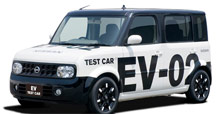Nissan has revealed the company’s own hybrid drive system and plans for a future all-electric car. Nissan has been selling a hybrid version of its Altima sedan in several markets for the past two years but the core technology of the vehicle, the petrol-electric hybrid drivetrain, is based on technology borrowed from Toyota.
Under the ‘Nissan GT 2012’ business plan, the company has committed to zero-emission vehicle leadership and confirmed plans to introduce an electric vehicle (EV) in 2010 in the United States and Japan. The plan is part of Nissan’s bid to catch up to rivals Toyota and Honda, which have both made substantial headway in the development of electric and hybrid technology while Nissan lagged behind.
Zero emission vehicles supplemented by hybrids
Powered by advanced lithium-ion batteries, the latest EV prototype is part of Nissan’s substantial research and development program on zero emission vehicles. This latest generation vehicle features a front-wheel drive layout and uses a newly developed 80kW motor. Although the prototype is based on the Japanese market Cube minicar, the production EV, to be introduced in 2010, will have a unique bodystyle and won’t be based on any existing Nissan model.
In order to bridge the gap between fully electric cars and standard combustion engines, however, Nissan recognises it will also need a hybrid powertrain. Its hybrid prototype, based on the Infiniti G35 sedan (which is not sold here), combines a rear-wheel drive layout with a parallel-powertrain hybrid system. The system features two clutches, allowing the electric motor to be directly connected to the engine and transmission via these two separate clutches, so it can assist the engine or be completely out of the loop as the need arises.
Two-clutch parallel hybrid system has several advantages
The parallel-powertrain hybrid system also eliminates the need for conventional torque converters, contributing to greater responsiveness and more linear acceleration for improved driving feel. Regenerative braking is part of the package as well, allowing the clutch to engage during braking to recapture energy that would otherwise be lost as heat in the brake system.
The system is capable of several different driving modes, including electric only drive at low speeds, electric idling of the engine, combined electric and petrol power at high loads, and petrol only power when cruising. Because the hybrid system is based on lithium-ion battery technology, its market release is scheduled for sometime after 2010.
The battery pack’s compact laminated configuration delivers twice the electric power compared to conventional nickel-metal hydride batteries with a cylindrical configuration. The compact batteries also allow for improved vehicle packaging and a wide range of applications. How many of these applications will reach Australian shores is still unknown, but given the expected increase in demand for fuel-saving hybrids and electric vehicles as petrol prices rise, the chances of them appearing in local showrooms is becoming more and more likely.

